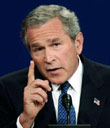
"It's good beef; it's healthy beef. As a matter of fact, I'm going to feed the prime minister's delegation a good hamburger for lunch," he said.
U.S. officials, along with the beef industry, have been pushing Japan to loosen its import rules on beef, hoping to rebuild a robust trade with the Asian nation. They want to see Japan accept meat from older animals and also seek an end to mandatory inspections of each box of beef.
Currently, Japan accepts U.S. meat from animals 20 months or younger, but exporters would like to see meat shipped from animals up to 30 months old. They would also like to see a full range of beef exports — boneless and bone-in.
But most industry officials do not expect any change until after a ruling next month from the World Animal Health Organization (OIE), which is expected to confirm the United States as a "controlled risk" country.
U.S. beef exports to Japan were about $1.4 billion a year until 2003, when mad cow disease was discovered in the United States. For 2006, that figured stood at $66 million.
Earlier this week, the Agriculture Department announced it would allow Japan to inspect U.S. beef processing plants, which puts the United States one step closer to more trade.
According to Agriculture Secretary Mike Johanns, Japan will drop its mandatory inspection rule for U.S. beef shipments once those plant visits take place.
Beef trade with Japan is just one instance in which U.S. agriculture interests complain trading partners fail to set import rules according to world health and safety standards.









